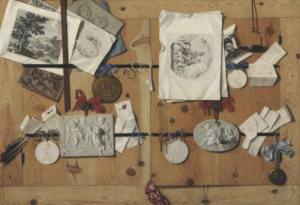Today’s post comes from Alicia Lewis, class of 2018 and Art Center Student Docent

While roaming the galleries of the Frances Lehman Loeb Art Center one day last semester, I noticed a newly installed painting in the 20th century gallery. It was a rather large painting, and the artist’s use of space on the long, narrow canvas was very unusual. The bottom half of the canvas was occupied by the portrait of a man, whereas the top half was left empty. I took a closer look at the painting and examined the label on the wall next to it, which read: Portrait of Barnett Newman by Hedda Sterne. I wasn’t familiar with this artist or her works, so I decided to do some research.
Hedda Sterne was born in Bucharest, Romania in 1910. She studied art history and philosophy at the University of Bucharest, but eventually decided to pursue her interests independently. She therefore spent a few years in Vienna, as well as France, where she worked with artists such as Ferdinand Léger, and was heavily influenced by Surrealism.
In 1941, Sterne fled Europe in fear of Nazi persecution. She moved to New York, where she was involved in the local art community and formed friendships with art dealers such as Betty Parsons and Peggy Guggenheim. These women introduced Sterne to the wider art world of New York, which allowed her to meet artists whom she would go on to form close friendships with. Many of these artists were part of the New York School of Abstract Expressionism. Sterne’s association with them led

to her presence in the now famous Life Magazine photograph of a group called “The Irascibles.” While working with these artists, Sterne met and became particularly close to Barnett Newman and his wife Annalee. According to William Grimes of the New York Times, Sterne “executed portraits of friends and colleagues throughout her career,”—among them were the Newmans.
When first examining Sterne’s Portrait of Barnett Newman, I knew that the figure wasn’t just any ordinary person. I felt a sense of serenity when looking at the painting and thought that the artist may have held this figure in great reverence. My eyes were glued to the lower portion of the canvas, and I kept wondering why Sterne had chosen to leave the top half of the canvas empty. Interestingly, she may have sought to create a dialogue between her work and some of the principles exhibited in Newman’s own work. For example, there is a sense of minimalism and a Zen-like quality to the painting, represented by its few colors and simple details. Barnett Newman’s paintings feature spare forms (which would influence later Minimalist painters), and he sought to create a “portal to the sublime,” giving viewers the opportunity to experience a sort of transcendence when viewing his works. Similarly, in Sterne’s portrait of Newman, there is a sense that the figure is otherworldly and of great importance. In addition to this, many of Barnett Newman’s most famous works are on large canvases where the entire canvas is covered in one color, with his now-famous vertical lines, or “zips,” running through them. According to curator Mary-Kay Lombino, Newman would paint these zips starting from the bottom of the canvas and work his way up. This may be one explanation for why Sterne chose to position Newman’s hand at the very bottom of the canvas.

Hedda Sterne was very good friends with Barnett Newman and many other Abstract Expressionists of the twentieth century. However, although Sterne’s works have been displayed in exhibitions with Abstract Expressionist and Surrealist works, she remained an independent artist throughout her life. Sterne claimed that she did not have any particular consistent style of painting. Rather, her artwork represented a flux in her imagination. As she changed, her work changed with her.
Sterne’s Portrait of Barnett Newman has since moved out of the twentieth-century gallery and is currently featured as one of the paintings in the temporary exhibition, XL: Large-Scale Paintings from the Permanent Collection. On the wall next to it is Portrait of Annalee Newman, also painted by Hedda Sterne. The two portraits, despite being on similar canvases, are very different from one another in terms of Sterne’s use of space. Whereas there is empty space on the top half of Portrait of Barnett Newman, there is a large chunk of empty space on the lower half of Portrait of Annalee Newman. The portraits of Barnett and Annalee Newman are an exciting component of XL, marking the first time the two works have been exhibited together. Side by side, Sterne’s two works provide viewers with a reason to ponder how an artist’s use of space, and also scale, impacts his or her works.




